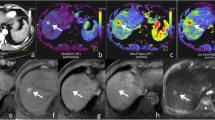Abstract
Hepatic perfusional changes are common in response to, or as a result of, a multitude of pathological processes. These can be neoplastic, inflammatory, fibrotic, or ischemic in origin, to name a few. The liver, having a dual blood supply, is a unique organ to study using contrast-enhanced CT and MRI imaging due to its varied appearance on multiphasic imaging. Knowledge of the CT and MRI appearance of hepatic perfusional changes, in addition to the clinical presentation, can often result in an accurate differential diagnosis. Many of the conditions that cause these changes in hepatic blood flow result in similar appearances on imaging. As a result, it is important that radiologists be aware of common pitfalls when dealing with hepatic perfusional changes to prevent misdiagnosis or delayed diagnosis. As such, this review will focus on some of the various causes of hepatic perfusional changes and how to accurately identify and diagnose them based on their CT and MRI appearance.
Graphic abstract
















Similar content being viewed by others
References
Lupescu IG, Grasu M, Capşa R, Pitrop A, Georgescu SA. Hepatic perfusion disorders: Computer-tomographic and magnetic resonance imaging. J Gastrointest Liver Dis 2006;15:273–9.
Torabi M, Hosseinzadeh K, Federle MP. CT of nonneoplastic epatic vascular and perfusion disorders. Radiographics 2008;28:1967–82. https://doi.org/10.1148/rg.287085067.
Li YL, Lee KH, Cheng AKC, Yu ML. Nutmeg liver. Abdom Radiol 2018;43:1275–6. https://doi.org/10.1007/s00261-017-1283-4.
Wells ML, Fenstad ER, Poterucha JT, Hough DM, Young PM, Araoz PA, et al. Imaging findings of congestive hepatopathy. Radiographics 2016;36:1024–37. https://doi.org/10.1148/rg.2016150207.
Das CJ, Soneja M, Tayal S, Chahal A, Srivastava S, Kumar A, et al. Role of radiological imaging and interventions in management of Budd–Chiari syndrome. Clin Radiol 2018;73:610–24. https://doi.org/10.1016/j.crad.2018.02.003.
Yang S, Wu J, Lei S. CT Features of Hepatic Veno-occlusive Disease: A Meta-analysis. Acad Radiol 2018;25:328–37. https://doi.org/10.1016/j.acra.2017.10.012.
Qi X, Han G, He C, Yin Z, Guo W, Niu J, et al. CT features of non-malignant portal vein thrombosis: A pictorial review. Clin Res Hepatol Gastroenterol 2012;36:561–8. https://doi.org/10.1016/j.clinre.2012.05.021.
Adler DD, Glazer GM, Silver TM. Computed tomography of liver infarction. Am J Roentgenol 1984;142:315–8. https://doi.org/10.2214/ajr.142.2.315.
Dickson AM. The focal hepatic hot spot sign. Radiology 2005;237:647–8. https://doi.org/10.1148/radiol.2372031690.
Costa AF, Clarke SE, Stueck AE, McInnes MDF, Thipphavong S. Benign Neoplasms, Mass-Like Infections, and Pseudotumors That Mimic Hepatic Malignancy at MRI. J Magn Reson Imaging 2020. https://doi.org/10.1002/jmri.27251.
Welle CL, Welch BT, Brinjikji W, Ehman EC, Venkatesh SK, Johnson MP, et al. Abdominal manifestations of hereditary hemorrhagic telangiectasia: a series of 333 patients over 15 years. Abdom Radiol 2019. https://doi.org/10.1007/s00261-019-01976-7.
Byun JH, Kim TK, Lee CW, Lee JK, Kim AY, Kim PN, et al. Arterioportal shunt: Prevalence in small hemangiomas versus that in hepatocellular carcinomas 3 cm or smaller at two-phase helical CT. Radiology 2004;232:354–60. https://doi.org/10.1148/radiol.2322030966.
Mathew RP, Sam M, Raubenheimer M, Patel V, Low G. Hepatic hemangiomas: the various imaging avatars and its mimickers. Radiol Medica 2020. https://doi.org/10.1007/s11547-020-01185-z.
Choi JY, Lee JM, Sirlin CB. CT and MR imaging diagnosis and staging of hepatocellular carcinoma: Part I. Development, growth, and spread: Key pathologic and imaging aspects. Radiology 2014;272:635–54. https://doi.org/10.1148/radiol.14132361.
Sica GT, Ji H, Ros PR. CT and MR Imaging of Hepatic Metastases. Am J Roentgenol 2000;174:691–8. https://doi.org/10.2214/ajr.174.3.1740691.
Sharma A, Houshyar R, Bhosale P, Choi J Il, Gulati R, Lall C. Chemotherapy induced liver abnormalities: an imaging perspective. Clin Mol Hepatol 2014;20:317–26. https://doi.org/10.3350/cmh.2014.20.3.317.
Kim SW, Shin HC, Kim IY. Transient arterial enhancement of the hepatic parenchyma in patients with acute cholangitis. J Comput Assist Tomogr 2009;33:398–404. https://doi.org/10.1097/rct.0b013e318186faa1.
Matsumoto K, Inoue F, Amano S, Tamura Y, Ashiarai M. Fitz-Hugh-Curtis Syndrome Preceded by Constipation in a 14-Year-Old Girl. Gynecol Obs Case Rep 2018;4:57. https://doi.org/10.21767/2471-8165.1000057.
de Boer JP, Verpalen IM, Gabriëls RY, de Haan H, Meijssen M, Bloembergen P, et al. Fitz-Hugh-Curtis syndrome resulting in nutmeg liver on computed tomography. Radiol Case Reports 2019;14:930–3. https://doi.org/10.1016/j.radcr.2019.04.008.
Zhang Y, Lu H, Ji H, Li Y. Inflammatory pseudotumor of the liver: A case report and literature review. Intractable Rare Dis Res 2015;4:155–8. https://doi.org/10.5582/irdr.2015.01021.
Kurowecki D, Patlas MN, Haider EA, Alabousi A. Cross-sectional pictorial review of IgG4-related disease. Br J Radiol 2019;92. https://doi.org/10.1259/bjr.20190448.
Faria SC, Ganesan K, Mwangi I, Shiehmorteza M, Viamonte B, Mazhar S, et al. MR imaging of liver fibrosis: Current state of the art. Radiographics 2009;29:1615–35. https://doi.org/10.1148/rg.296095512.
Chandarana H, Fowler UC San Diego Alice Fung KJ, Ganeshan Sir Reliance Foundation Rajan Gupta KH, Harris Vancouver Imaging Thomas Hope San Francisco Jeanne Horowitz AU, Hussain H, Sahani Massachusetts General Hospital Claude Sirlin UC San Diego Vahid Yaghmai DB. LI-RADS ® v2018 CT/MRI Core LI-RADS ® Technique. n.d.
Funding
This paper received no funding.
Author information
Authors and Affiliations
Corresponding author
Ethics declarations
Conflict of interest
The authors have no conflicts of interest to declare.
Additional information
Publisher's Note
Springer Nature remains neutral with regard to jurisdictional claims in published maps and institutional affiliations.
CME activity This article has been selected as the CME activity for the current month. Please visit https://ce.mayo.edu/node/103495 and follow the instructions to complete this CME activity.
Rights and permissions
About this article
Cite this article
Gunter, D., Riaz, S., Haider, E.A. et al. Hepatic perfusional changes on CT and MRI: a radiology primer. Abdom Radiol 46, 179–196 (2021). https://doi.org/10.1007/s00261-020-02787-x
Received:
Revised:
Accepted:
Published:
Issue Date:
DOI: https://doi.org/10.1007/s00261-020-02787-x




